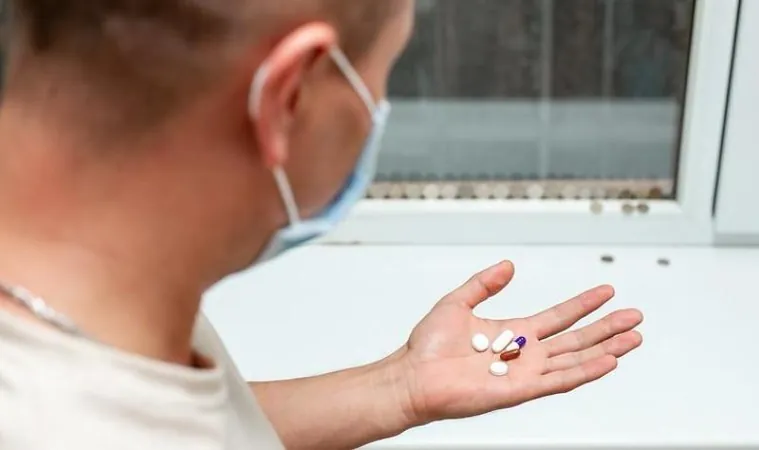
Alarming Rise of Drug-Resistant Tuberculosis: Study Unveils Risks to New Treatments!
2025-01-09
Author: Sarah
Overview
A recent study has raised serious concerns about the emergence and spread of resistance to innovative drug regimens designed to combat multidrug-resistant tuberculosis (MDR-TB). Conducted by a team from the Swiss Tropical and Public Health Institute in collaboration with Georgia's National Center for Tuberculosis and Lung Diseases, the findings highlight a worrisome trend: more than 500 strains of MDR-TB now exhibit resistance to at least one component of the promising BPaL/M treatment (which consists of bedaquiline, pretomanid, and linezolid, with or without moxifloxacin).
Key Findings
Published in the prestigious New England Journal of Medicine, the letter reveals that over 25% of these identified strains appear to have been transmitted between patients—a clear indication that the battle against this deadly disease is far from over.
The BPaL/M Treatment Regimen
The new BPaL/M regimen, endorsed by the World Health Organization (WHO) in 2022, represents a monumental leap forward in TB treatment. With a treatment duration of just six months, it is a significant improvement over the previous 15-month injectables, which often caused severe side effects and deterred patients from completing their therapy. Recent trials have heralded BPaL/M's cure rate to exceed 90%, in stark contrast to the sub-50% rates of earlier treatments.
Challenges Ahead
However, researchers behind the study have warned that while this new regimen is transformative, the bacteria responsible for TB are likely to adapt. Senior author Dr. Sébastien Gagneux expressed the necessity of understanding how Mycobacterium tuberculosis might respond to the widespread implementation of BPaL/M, emphasizing,"Outsmarting the bacteria is a significant challenge."
Genomic Analysis
The research team meticulously analyzed the genomes of over 6,900 M. tuberculosis isolates from Georgia—a hotspot for MDR-TB over the past 13 years. They uncovered distinct mutations that indicated resistance not only to first-line medications but also to drugs within the newly introduced BPaL/M regimen. Alarmingly, 28% of the strains analyzed demonstrated identical mutations, hinting at patient-to-patient transmission.
International Findings
To broaden their investigation, the researchers explored an extensive database of 81,576 genomes from 26 countries, uncovering a total of 454 highly drug-resistant strains, with a staggering 28% linked to recent transmissions among patients.
Concern of Total Resistance
One particularly concerning finding was the discovery of nine strains that exhibited resistance to all BPaL/M drugs, classified as "totally drug-resistant." Regions impacted include Belarus, Georgia, India, and South Africa—areas already grappling with high MDR-TB burdens.
Future Implications
While the overall number of these cases remains low at present, the fact that significant patient-to-patient transmission is occurring just two years post-WHO endorsement is deeply concerning. The WHO estimates that approximately 400,000 individuals developed MDR-TB globally in 2023, and a recent survey projected that the BPaL/M regimen could cover 78% of MDR-TB patients by 2026.
Conclusion
The hope is that the convenience of the shorter regimen will enhance patient adherence and mitigate the ongoing crisis. Yet, study authors caution that, without substantial improvements in diagnostic capabilities, infection control measures, and ongoing surveillance, the long-term efficacy of this groundbreaking treatment could be jeopardized.
Call to Action
The fight against drug-resistant tuberculosis continues, and it is imperative that public health officials ramp up their efforts to safeguard healthcare practices and intervention strategies. A significant paradigm shift is needed now to ensure this innovative treatment does not become ineffectual in the face of relentless bacterial adaptation.

 Brasil (PT)
Brasil (PT)
 Canada (EN)
Canada (EN)
 Chile (ES)
Chile (ES)
 Česko (CS)
Česko (CS)
 대한민국 (KO)
대한민국 (KO)
 España (ES)
España (ES)
 France (FR)
France (FR)
 Hong Kong (EN)
Hong Kong (EN)
 Italia (IT)
Italia (IT)
 日本 (JA)
日本 (JA)
 Magyarország (HU)
Magyarország (HU)
 Norge (NO)
Norge (NO)
 Polska (PL)
Polska (PL)
 Schweiz (DE)
Schweiz (DE)
 Singapore (EN)
Singapore (EN)
 Sverige (SV)
Sverige (SV)
 Suomi (FI)
Suomi (FI)
 Türkiye (TR)
Türkiye (TR)
 الإمارات العربية المتحدة (AR)
الإمارات العربية المتحدة (AR)